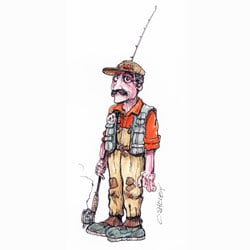Fashion has sneaked into outdoor sports quieter than a black snake into a robin’s nest. Somewhere along the way, we switched from army fatigues to camo best described as designer shrubbery. Rolling into hunt camp in bib overalls today would be the equivalent of attending your daughter’s wedding in boxer shorts and fireman’s boots.
The clothing industry has already taken notice. You can buy a variety of camo patterns ranging from hardwood to poison oak, snow field to desert, and sand to muck. It’s just a matter of time until someone has a suit that changes color with the fall season. Hopefully, it stops before it sheds its leaves. Clothes like that could get a fellow arrested.
One of the great challenges for the clothing industry is that we get our clothes in gun shops and marinas. Marketers have trouble selling high-fashion attire to someone also buying a chili dog to go. Likewise, I’m not sure I want fashion advice from the same guy who lubes my outboard.
That’s probably why the mail-order houses have such a booming business. But there’s another reason, too. Hunters tend to be self-conscious about trying on clothes, especially when it involves stripping to your skivvies in the closet of a tackle shop.
Marketers have another challenge in hunting clothes, namely, advertising. How do you encourage someone to make a fashion statement by not being seen? I can hear it now.
“Wear our new Weedy Camo and no one will notice you. Not only will you not be the hit of the hunting party, they won’t even know you’re there!”
Keeping up with these fashions is no simple matter. Outdoorsmen have no fashion magazines. No Cosmopolitan, no Gentleman’s Quarterly. Maybe we need one, something like Field Dress. It would probably sell a million copies with the first issue, mostly to people thinking they would learn how to gut a deer.
If you think about it, clothing has a major impact on society. We live by slogans like, “Clothes make the man” or “Dress for success.” When hunting fashion becomes established, we’ll probably have our own slogans. I can imagine something like, “If you don’t dress for your game, you won’t have game to dress.”
 Fashion designers have their work cut out for them when it comes to hunters. Take tennis shoes, for instance. They’re a multi-billion dollar industry and hunters rarely wear them. Just think about heading into the field with a pair of those pumpable tennis shoes in a nice camo pattern. Before you went a hundred yards, you’d probably hit a cat-brier and have a blowout. Worse yet, what if you were floating in by canoe and tipped? You’d float feet up.
Fashion designers have their work cut out for them when it comes to hunters. Take tennis shoes, for instance. They’re a multi-billion dollar industry and hunters rarely wear them. Just think about heading into the field with a pair of those pumpable tennis shoes in a nice camo pattern. Before you went a hundred yards, you’d probably hit a cat-brier and have a blowout. Worse yet, what if you were floating in by canoe and tipped? You’d float feet up.
Shirt designers often dress up their clothing with emblems of jumping horses and golf clubs. This has already begun to spill over into outdoor wear with flying ducks, flushing quail, and leaping trout. They do need to draw the line somewhere, however. For instance, some of the stuff that could be put on a catfisherman’s shirt would scare small children.
Breathable rainwear has become a part of every hunter’s wardrobe, even though none of us have actually seen it inhale or exhale. In fact, mine seems to have a sinus condition. Once, as I was working a gobbler, my raincoat sneezed and emptied all my pockets, giving new meaning to Fowl Weather Gear.
Some questions about breathable rainwear are not covered in the fine print. For instance, can breathable rainwear hyperventilate? Better yet, if I fall in with my pump tennis shoes and float upside down, will my breathable rainwear drown?
Other clothing accessories designed for hunters suffer from insufficient thought about its intended use. One that particularly needs work is the glove without finger tips. What was that designer thinking? What gets cold first? Where does frostbite start? How many of us get arthritis in our palms? Someone should buy up all those leftover finger tips and sell them instead of the gloves.
Another challenge for the well-dressed hunter is how to clean his upscale hunting clothes. In the past, camo jumpsuits were worn around camp until they stood on their own and then they were field-dressed. Most hunters stay in areas too remote for dry-cleaners. So what do we do with dusty camo? Clear-cut? Bush-hog it? Spray it with Round-Up?
Ironing will never catch on in the hunt camp. The closest we’ll ever come to pressing clothes will be backing over them with the truck.
All in all, improved fashion on the hunting scene is probably a good thing. Hunters these days need to present the best image possible. Still, I’m a little uncomfortable coming out of a tackle-shop closet to ask my hunting buddy if this camo makes my butt look like a stump.
Looking for hunting land of your own? View rural land for sale throughout the South, in Florida, Georgia and Texas our parent company's website at RaydientPlaces.com.

























